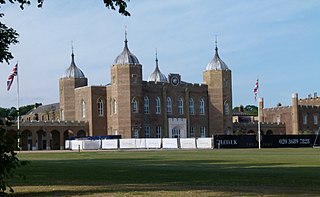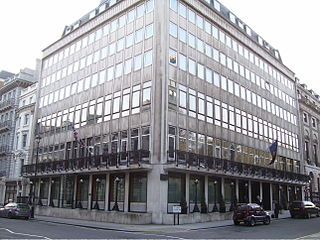
The Royal Military Academy (RMA) at Woolwich, in south-east London, was a British Army military academy for the training of commissioned officers of the Royal Artillery and Royal Engineers. It later also trained officers of the Royal Corps of Signals and other technical corps. RMA Woolwich was commonly known as "The Shop" because its first building was a converted workshop of the Woolwich Arsenal.

Hertford is the county town of Hertfordshire, England, and is also a civil parish in the East Hertfordshire district of the county. The parish had a population of 26,783 at the 2011 census.

Pall Mall is a street in the St James's area of the City of Westminster, Central London. It connects St James's Street to Trafalgar Square and is a section of the regional A4 road. The street's name is derived from pall-mall, a ball game played there during the 17th century, which in turn is derived from the Italian pallamaglio, literally "ball-mallet".

St James's is a central district in the City of Westminster, London, forming part of the West End. The area was once part of the northwestern gardens and parks of St. James's Palace. During the Restoration in the 17th century, the area was developed as a residential location for the British aristocracy, and around the 19th century was the focus of the development of their gentlemen's clubs. Once part of the parish of St Martin in the Fields, much of it formed the parish of St James from 1685 to 1922. Since the Second World War the area has transitioned from residential to commercial use.

The Devonshire Club was a London gentlemen's club which was established in 1874 and was disbanded in 1976. Throughout its existence it was based at 50 St James's Street. The major Liberal club of the day was the Reform Club, but in the wake of the Reform Act 1867's extension of the franchise, the waiting list for membership from the larger electorate grew to such an extent that a new club was formed to accommodate these new Liberal voters. The clubhouse was on the western side of St James's Street. The original intention was to call it the 'Junior Reform Club', along the model of the Junior Carlton Club formed in 1866, but complaints from the Reform Club's members led it to being named the Devonshire, in honour of its first chairman, the Duke of Devonshire, an aristocrat from a long line of Liberals.

The Naval and Military Club, known informally as The In & Out, is a private members' club located in St James's Square, London. It was founded in 1862 for officers of the Navy and Army. It now also accepts female members, and members who have not served in the armed forces, but continues to observe service traditions.

The Caledonian Club is a prestigious Scottish-focused London members' club located at 9 Halkin Street SW1, near Belgrave Square in Belgravia, London, SW1.
William Crockford was an English Regency entrepreneur; horse racing enthusiast and proprietor of the infamous gambling club Crockford's who became one of the richest men in England.

Boodle's is a gentlemen's club in London, England, with its clubhouse located at 28 St James's Street. Founded in January 1762 by Lord Shelburne, who later became Prime Minister of the United Kingdom and then 1st Marquess of Lansdowne, it is the second oldest private members' club in London and in the world.

Pratt's is a gentlemen's club in London, England. It was established in 1857, with premises in a house in Park Place, off St James's Street, and close to the Ritz.

The Army and Navy Club in London is a private members' club founded in 1837 for British Army and Royal Navy Officers, it also known informally as The Rag. The Club offers Military membership to anyone who holds or has held a Commission in the British Armed Forces or in Commonwealth Forces, the club also now accepts applications for Non Military membership.

The Bath Club was a sports-themed London gentlemen's club in the 20th century. It was established in 1894 at 34 Dover Street. Its swimming pool was a noted feature, and it is thought that the swimming pool of the fictional Drones Club was based on this. It is also where Princess Margaret and Queen Elizabeth II learned to swim. It was one of the few gentleman's clubs that admitted women. Sir Henry "Chips" Channon was a member. Mark Twain stayed here when he visited London. Guglielmo Marconi stayed here as well when he visited London.

The Constitutional Club was a London gentlemen's club, now dissolved, which was established in 1883 and disbanded in 1979. Between 1886 and 1959 it had a distinctive red and yellow Victorian terracotta building, designed by Robert William Edis, at 28 Northumberland Avenue, off Trafalgar Square.

The Green Room Club was a London-based club, primarily for actors, but also for lovers of theatre, arts and music. It was established in 1877 in a restaurant in Piccadilly Circus, and moved to premises on Adam Street in 1955, where it remained until its closure in 2004.

The Conservative Club was a London gentlemen's club, now dissolved, which was established in 1840. In 1950 it merged with the Bath Club, and was disbanded in 1981. From 1845 until 1959, the club occupied a building at 74 St James's Street where the Thatched House Tavern had previously stood.

The Public Schools Club is a former London gentlemen's club.

Crockford's, the popular name for William Crockford's St James's Club was a London gentlemen's club, now dissolved. It was established in 1823, closed in 1845, re-founded in 1928 and closed in 1970. One of London's older clubs, it was centred on gambling and maintained a somewhat raffish and raucous reputation. It was founded by William Crockford who employed Benjamin Wyatt and Philip Wyatt to construct the city's most opulent palace of gentlemanly pleasure, which opened in November 1827. and he employed two of London's finest chefs of the time, Louis Eustache Ude and then Charles Elmé Francatelli to feed its members, food and drink being supplied free after midnight.

Daly's Club, with premises known as Daly's Club House, was a gentlemen's club in Dublin, Ireland, a centre of social and political life between its origins in about 1750 and its end in 1823.

Brooks's is a gentlemen's club in St James's Street, London. It is one of the oldest and most exclusive gentlemen's clubs in the world.

The Pickwick Club is a private gentlemen's club in New Orleans, Louisiana. Founded in 1857, The Pickwick Club and the Mistick Krewe were originally one group comprising two organizations. After The Boston Club, The Pickwick Club is the second oldest remaining in the city.



















